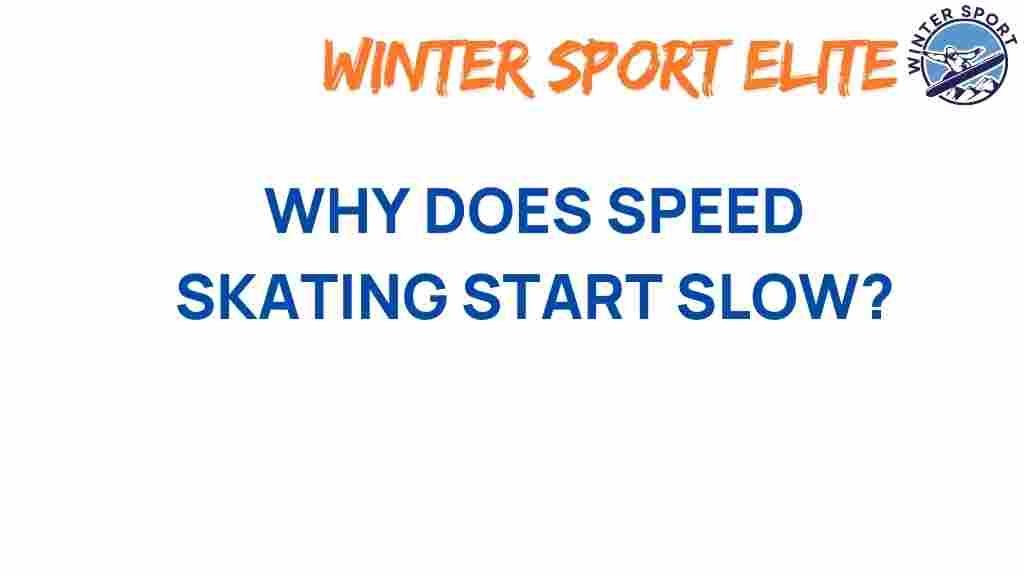Unraveling the Mystery: Why Does Speed Skating Start Slow?
Speed skating is a fascinating winter sport that combines technique, athleticism, and strategy. One of the most intriguing aspects of speed skating is the seemingly slow start that skaters often exhibit at the beginning of their races. Many spectators wonder why athletes who are capable of reaching astonishing speeds start their races at a slower pace. In this article, we will explore the dynamics of speed skating, focusing on the techniques involved in acceleration, the importance of performance, and the training regimens that contribute to this unique phenomenon.
Understanding Speed Skating Dynamics
The dynamics of speed skating are essential for understanding why these athletes start slow. Speed skating involves not just raw speed but also a complex interplay of technique and physics. Here are some key factors that contribute to the starting dynamics:
- Technique: The technique employed in speed skating is critical. Athletes must balance their body position, blade angle, and stroke efficiency to maximize their speed.
- Acceleration: Acceleration plays a significant role in how skaters build their speed. Starting slowly allows skaters to gather momentum gradually.
- Energy Conservation: Beginning with a slow start helps athletes conserve energy for the more demanding phases of the race.
The Importance of Technique in Speed Skating
Technique is the cornerstone of effective speed skating. Athletes must master various elements, including:
- Body Position: A low center of gravity helps maintain balance and reduces air resistance.
- Blade Control: Proper blade technique enhances grip on the ice, enabling smoother transitions from slow to fast.
- Stroke Mechanics: Skaters utilize long, powerful strokes to accelerate efficiently.
Each of these elements contributes to the overall performance of a speed skater, especially during the critical moments of acceleration.
Acceleration: The Key to Speed Skating Performance
Acceleration in speed skating is not just about going fast; it’s about how effectively a skater can transition from a standing start to their maximum velocity. Here’s how it works:
- Initial Push: The first few strides are crucial. Skaters must push off with great force while maintaining balance.
- Stride Length vs. Frequency: Finding the right balance between the length of each stride and the frequency of strokes is essential for optimal acceleration.
- Body Mechanics: Engaging core muscles and maintaining a forward lean allows for better propulsion.
These factors work together to create a powerful acceleration phase, despite the initial slow start.
Training Regimens for Speed Skaters
Training is vital for speed skating athletes, focusing on both strength and technique. Here are some common training components:
- Strength Training: Building leg and core strength is essential for powerful starts.
- Technique Drills: Regular practice of starts and acceleration techniques ensures skaters develop proper form.
- Endurance Training: Skaters must build their cardiovascular endurance to maintain high speeds throughout a race.
Through rigorous training, athletes refine their skills and enhance their performance, preparing them for the demands of competition.
Common Troubleshooting Tips for Skaters
Even with diligent training, skaters may encounter challenges during their starts. Here are some troubleshooting tips to help improve performance:
- Focus on Technique: Regularly review and practice the mechanics of starting to ensure proper form.
- Video Analysis: Use video recordings to analyze your start and identify areas for improvement.
- Work with a Coach: Getting feedback from a coach can provide valuable insights into your technique.
By addressing these issues, athletes can enhance their acceleration and overall speed skating performance.
Competitive Aspects of Speed Skating
In the realm of winter sports, speed skating is highly competitive. Understanding how skaters manage their starts can impact their performance during races:
- Strategic Starts: Some athletes may choose to start slowly to gauge their competitors.
- Pacing: A slow start can be part of a pacing strategy to prevent fatigue.
- Timing: Knowing when to accelerate can be crucial in a race, as it can make or break a performance.
Skaters must constantly evaluate their strategies and adapt to the dynamics of their competitions.
Conclusion: The Art of a Slow Start in Speed Skating
In conclusion, the slow start in speed skating is a complex interplay of technique, acceleration, and performance strategy. By understanding the dynamics involved, athletes can optimize their training and improve their competitive edge. Whether you are an aspiring speed skater or a fan of winter sports, appreciating the intricacies of this sport can deepen your enjoyment and understanding of the athletes’ efforts.
For more insights into speed skating techniques and training, check out this comprehensive guide. And for the latest updates in winter sports, visit this resource.
Embrace the slow start, and witness the remarkable acceleration that follows in the thrilling world of speed skating!
This article is in the category Training and created by WinterSportElite Team
